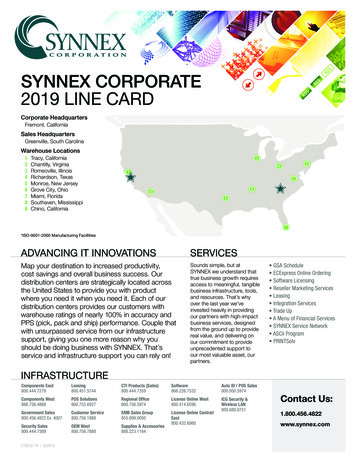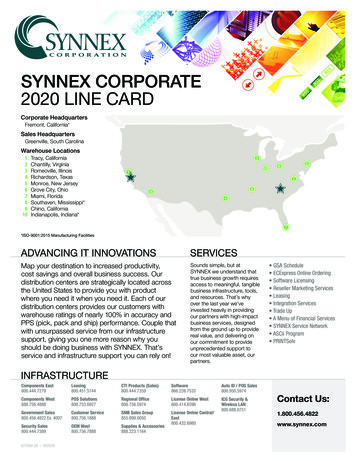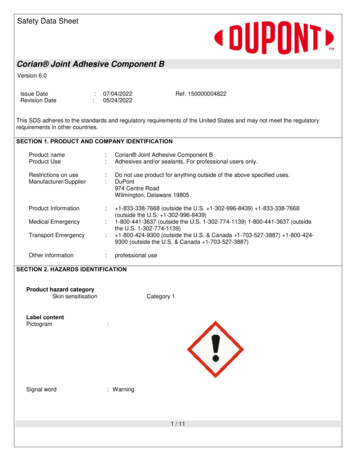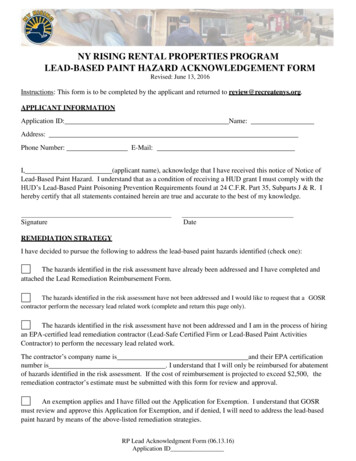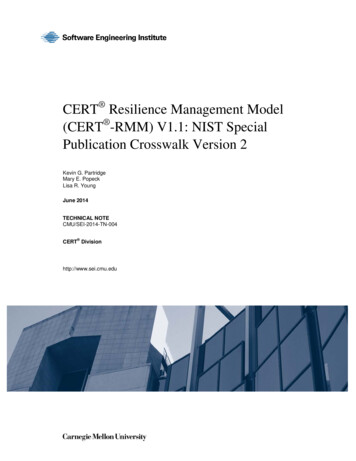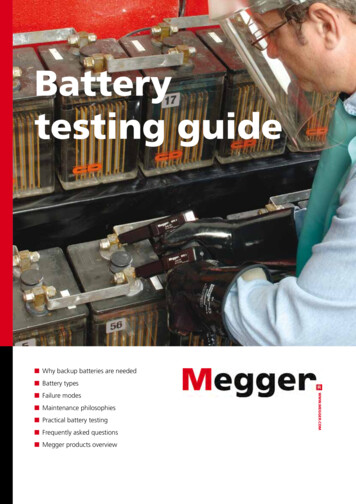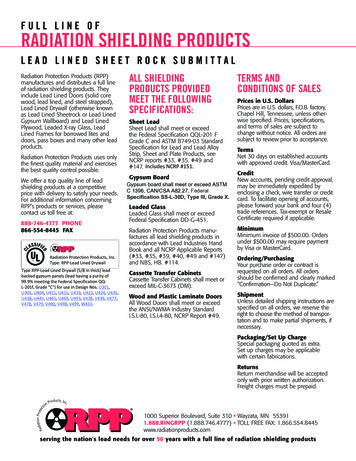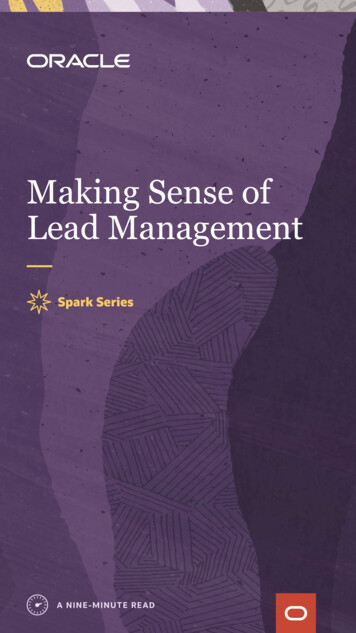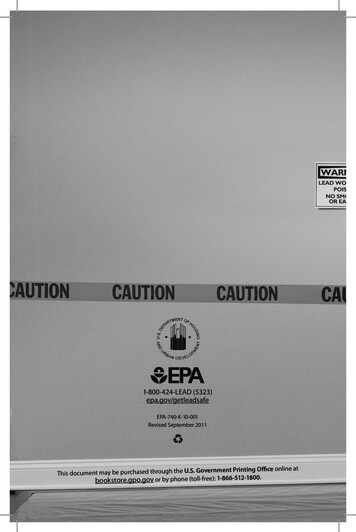
Transcription
1-800-424-LEAD (5323)epa.gov/getleadsafeEPA-740-K-10-001Revised September 2011ment Printing Office online atThis document may be purchased through the U.S. gpo.gov or
THE LEAD-SAFE CERTIFIED GUIDE TORENOVATERIGHTImportant lead hazard information forfamilies, child care providers and schools.AD- SAFELET IFIE D F I RMCER
IT’S THE LAW!Federal law requires contractors that disturb painted surfacesin homes, child care facilities and schools built before 1978 tobe certified and follow specific work practices to prevent leadcontamination. Always ask to see your contractor’s certification.Federal law requires that individuals receive certain informationbefore renovating more than six square feet of painted surfacesin a room for interior projects or more than twenty square feetof painted surfaces for exterior projects or window replacementor demolition in housing, child care facilities and schools builtbefore 1978. Homeowners and tenants: renovators must give you thispamphlet before starting work. Child care facilities, including preschools and kindergartenclassrooms, and the families of children under six years of agethat attend those facilities: renovators must provide a copyof this pamphlet to child care facilities and general renovationinformation to families whose children attend those facilities.
WHO SHOULD READ THIS PAMPHLET?This pamphlet is for you if you: Reside in a home built before 1978. Own or operate a child care facility, including preschools and kindergartenclassrooms, built before 1978, or Have a child under six years of age who attends a child care facility built before 1978.You will learn: Basic facts about lead and your health. How to choose a contractor, if you are a property owner. What tenants, and parents/guardians of a child in a child care facility or schoolshould consider. How to prepare for the renovation or repair job. What to look for during the job and after the job is done. Where to get more information about lead.This pamphlet is not for: A batement projects. Abatement is a set of activities aimed specifically ateliminating lead or lead hazards. EPA has regulations for certification and training ofabatement professionals. If your goal is to eliminate lead or lead hazards, contact theNational Lead Information Center at 1-800-424-LEAD (5323) for more information. “ Do-it-yourself” projects. If you plan to do renovation work yourself, this documentis a good start, but you will need more information to complete the work safely. Callthe National Lead Information Center at 1-800-424-LEAD (5323) and ask for moreinformation on how to work safelyin a home with lead-based paint. C ontractor education. Contractorswho want information about workingsafely with lead should contactthe National Lead InformationCenter at 1-800-424-LEAD (5323)for information about courses andresources on lead-safe work practices.1
RENOVATING, REPAIRING, OR PAINTING? Is your home, your building, or the child care facilityor school your children attend being renovated,repaired, or painted? Was your home, your building, or the child care facilityor school where your children under six years of ageattend built before 1978?If the answer to these questions is YES, there are afew important things you need to know aboutlead-based paint.This pamphlet provides basic facts about lead andinformation about lead safety when work is beingdone in your home, your building or the child carefacility or school your children attend.The Facts About Lead Lead can affect children’s brains and developing nervous systems, causing reducedIQ, learning disabilities, and behavioral problems. Lead is also harmful to adults. Lead in dust is the most common way people are exposed to lead. People can alsoget lead in their bodies from lead in soil or paint chips. Lead dust is often invisible. Lead-based paint was used in more than 38 million homes until it was banned forresidential use in 1978. Projects that disturb painted surfaces can create dust and endanger you and yourfamily. Don’t let this happen to you. Follow the practices described in this pamphletto protect you and your family.2
LEAD AND YOUR HEALTHLead is especially dangerous to childrenunder six years of age.Lead can affect children’s brains and developingnervous systems, causing: Reduced IQ and learning disabilities. Behavior problems.Even children who appear healthy can havedangerous levels of lead in their bodies.Lead is also harmful to adults. In adults, low levelsof lead can pose many dangers, including: High blood pressure and hypertension. Pregnant women exposed to lead can transfer lead to their fetuses. Lead gets intothe body when it is swallowed or inhaled. People, especially children, can swallow lead dust as they eat, play, and do othernormal hand-to-mouth activities. People may also breathe in lead dust or fumes if they disturb lead-based paint.People who sand, scrape, burn, brush, blast or otherwise disturb lead-basedpaint risk unsafe exposure to lead.What should I do if I am concerned about my family’s exposure to lead? A blood test is the only way to find out if you or a family member already has leadpoisoning. Call your doctor or local health department to arrange for a blood test. Call your local health department for advice on reducing and eliminatingexposures to lead inside and outside your home, child care facility or school. Always use lead-safe work practices when renovation or repair will disturbpainted surfaces.For more information about the health effects of exposure to lead, visit the EPA leadwebsite at epa.gov/lead/pubs/leadinfo or call 1-800-424-LEAD (5323).There are other things you can do to protect your family every day. Regularly clean floors, window sills, and other surfaces. Wash children’s hands, bottles, pacifiers, and toys often. Make sure children eat a healthy, nutritious diet consistent with the USDA's dietaryguidelines, that helps protect children from the effects of lead. Wipe off shoes before entering the house.3
WHERE DOES THE LEAD COME FROM?Dust is the main problem.The most common way to get lead in the body is from dust. Lead dust comes fromdeteriorating lead-based paint and lead-contaminated soil that gets tracked intoyour home. This dust may accumulate to unsafe levels. Then, normal hand to-mouthactivities, like playing and eating (especially in young children), move that dust fromsurfaces like floors and window sills into the body.Home renovation creates dust.Common renovation activities like sanding, cutting, and demolition can createhazardous lead dust and chips.Proper work practices protect you from the dust.The key to protecting yourself and your family during a renovation, repair or paintingjob is to use lead-safe work practices such as containing dust inside the work area,using dust-minimizing work methods, and conducting a careful cleanup, as describedin this pamphlet.Other sources of lead.Remember, lead can also come from outside soil, your water, or household items(such as lead-glazed pottery and lead crystal). Contact the National Lead InformationCenter at 1-800-424-LEAD (5323) for more information on these sources.4
CHECKING YOUR HOME FOR LEAD-BASED PAINTOlder homes, child care facilities, and schools are more likely to containlead-based paint.Homes may be single-family homes or apartments. They may be private, governmentassisted, or public housing. Schools are preschools and kindergarten classrooms. Theymay be urban, suburban, or rural.You have the following options:You may decide to assume your home, child care facility, or school contains lead.Especially in older homes and buildings, you may simply want to assume lead-basedpaint is present and follow the lead-safe work practices described in this brochureduring the renovation, repair, or painting job.You can hire a certified professional to check for lead-based paint.These professionals are certified risk assessors or inspectors, and can determine ifyour home has lead or lead hazards. A certified inspector or risk assessor can conduct an inspection telling you whetheryour home, or a portion of your home, has lead-based paint and where it is located.This will tell you the areas in your home where lead-safe work practices are needed. A certified risk assessor can conduct a risk assessment telling you if your homecurrently has any lead hazards from lead in paint, dust, or soil. The risk assessorcan also tell you what actions to take to address any hazards. For help finding a certified risk assessor or inspector, call the National LeadInformation Center at 1-800-424-LEAD (5323).You may also have a certified renovator test the surfaces or components beingdisturbed for lead by using a lead test kit or by taking paint chip samples and sendingthem to an EPA-recognized testing laboratory. Test kits must be EPA-recognized andare available at hardware stores. They include detailed instructions for their use.5
FOR PROPERTY OWNERSYou have the ultimate responsibility for the safety of your family, tenants, or childrenin your care.This means properly preparing for the renovation and keeping persons out of the workarea (see p. 8). It also means ensuring the contractor uses lead-safe work practices.Federal law requires that contractors performing renovation, repair and painting projectsthat disturb painted surfaces in homes, child care facilities, and schools built before 1978be certified and follow specific work practices to prevent lead contamination.Make sure your contractor is certified, and can explain clearly the details of the joband how the contractor will minimize lead hazards during the work. You can verify that a contractor is certified by checking EPA’s website atepa.gov/getleadsafe or by calling the National Lead Information Center at1-800-424-LEAD (5323). You can also ask to see a copy of the contractor’sfirm certification. Ask if the contractor is trained to perform lead-safe work practices and to see acopy of their training certificate. Ask them what lead-safe methods they will use to set up and perform the job in yourhome, child care facility or school. Ask for references from at least three recent jobs involving homes built before 1978,and speak to each personally.Always make sure the contract is clear about how the work will be set up,performed, and cleaned. Share the results of any previous lead tests with the contractor. You should specify in the contract that they follow the work practices described onpages 9 and 10 of this brochure. The contract should specify which parts of your home are part of the work area andspecify which lead-safe work practices will be used in those areas. Remember, yourcontractor should confine dust and debris to the work area and should minimizespreading that dust to other areas of the home. The contract should also specify that the contractor will clean the work area, verifythat it was cleaned adequately, and re-clean it if necessary.If you think a worker is not doing what he is supposed to do or is doing somethingthat is unsafe, you should: Direct the contractor to comply with regulatory and contract requirements. Call your local health or building department, or Call EPA's hotline 1-800-424-LEAD (5323).If your property receives housing assistance from HUD (or a state or local agency thatuses HUD funds), you must follow the requirements of HUD’s Lead-Safe Housing Ruleand the ones described in this pamphlet.6
FOR TENANTS AND FAMILIES OF CHILDREN UNDER SIXYEARS OF AGE IN CHILD CARE FACILITIES AND SCHOOLSYou play an important role ensuring the ultimatesafety of your family.This means properly preparing for the renovationand staying out of the work area (see p. 8).Federal law requires that contractors performingrenovation, repair and painting projects that disturbpainted surfaces in homes built before 1978 and inchild care facilities and schools built before 1978, thata child under six years of age visits regularly, to becertified and follow specific work practices to preventlead contamination.The law requires anyone hired to renovate, repair, or dopainting preparation work on a property built before1978 to follow the steps described on pages 9 and 10 unless the area where the workwill be done contains no lead-based paint.If you think a worker is not doing what he is supposed to do or is doing somethingthat is unsafe, you should: C ontact your landlord. C all your local health or building department, or C all EPA's hotline 1-800-424-LEAD (5323).If you are concerned about lead hazards left behind after the job is over, you cancheck the work yourself (see page 10).7
PREPARING FOR A RENOVATIONThe work areas should not be accessible to occupants while the work occurs.The rooms or areas where work is being done may need to be blocked off or sealedwith plastic sheeting to contain any dust that is generated. Therefore, the containedarea may not be available to you until the work in that room or area is complete,cleaned thoroughly, and the containment has been removed. Because you may nothave access to some areas during the renovation, you should plan accordingly.You may need: A lternative bedroom, bathroom, and kitchen arrangements if work is occurring inthose areas of your home. A safe place for pets because they too can be poisoned by lead and can track leaddust into other areas of the home. A separate pathway for the contractor from the work area to the outside in order tobring materials in and out of the home. Ideally, it should not be through the sameentrance that your family uses. A place to store your furniture. All furniture and belongings may have to be movedfrom the work area while the work is being done. Items that can’t be moved, such ascabinets, should be wrapped in plastic. T o turn off forced-air heating and air conditioning systems while the work is beingdone. This prevents dust from spreading through vents from the work area to therest of your home. Consider how this may affect your living arrangements.You may even want to move out of your home temporarily while all or part of thework is being done.Child care facilities and schools may want to consider alternative accommodationsfor children and access to necessary facilities.8
DURING THE WORKFederal law requires contractors that are hired to perform renovation, repair and paintingprojects in homes, child care facilities, and schools built before 1978 that disturb paintedsurfaces to be certified and follow specific work practices to prevent lead contamination.The work practices the contractor must follow include these three simple procedures,described below:1. Contain the work area. The area must be contained so that dust and debris do not escapefrom that area. Warning signs must be put up and plastic or other impermeable materialand tape must be used as appropriate to: C over the floors and any furniture that cannot be moved. S eal off doors and heating and cooling system vents. For exterior renovations, cover the ground and, in some instances, erect verticalcontainment or equivalent extra precautions in containing the work area.These work practices will help prevent dust or debris from getting outside the work area.2. Avoid renovation methods that generate large amounts of lead-contaminated dust.Some methods generate so much lead-contaminated dust that their use is prohibited.They are: O pen flame burning or torching. Sanding, grinding, planing, needle gunning,or blasting with power tools and equipmentnot equipped with a shroud and HEPAvacuum attachment. U sing a heat gun at temperatures greaterthan 1100 F.There work places will eliminate dust, but some renovation methods make less dust thanothers. Contractors may choose to use various methods to minimize dust generation,including using water to mist areas before sanding or scraping; scoring paint beforeseparating components; and prying and pulling apart components instead of breakingthem.3. Clean up thoroughly. The work area should be cleaned up daily to keep it as clean aspossible. When all the work is done, the area must be cleaned up using special cleaningmethods before taking down any plastic that isolates the work area from the rest of thehome. The special cleaning methods should include: U sing a HEPA vacuum to clean up dust and debris on all surfaces, followed by W et wiping and wet mopping with plenty of rinse water.When the final cleaning is done, look around. There should be no dust, paint chips, or debrisin the work area. If you see any dust, paint chips, or debris, the area must be re-cleaned.9
FOR PROPERTY OWNERS: AFTER THE WORK IS DONEWhen all the work is finished, you will want to know if your home, child care facility, orschool where children under six attend has been cleaned up properly.EPA Requires Cleaning Verification.In addition to using allowable work practices and working in a lead-safe manner,EPA’s RRP rule requires contractors to follow a specific cleaning protocol. The protocolrequires the contractor to use disposable cleaning cloths to wipe the floor and othersurfaces of the work area and compare these cloths to an EPA-provided cleaningverification card to determine if the work area was adequately cleaned. EPA researchhas shown that following the use of lead-safe work practices with the cleaningverification protocol will effectively reduce lead-dust hazards.Lead-Dust Testing.EPA believes that if you use a certified and trained renovation contractor who followsthe LRRP rule by using lead-safe work practices and the cleaning protocol after thejob is finished, lead-dust hazards will be effectively reduced. If, however, you areinterested in having lead-dust testing done at the completion of your job, outlinedbelow is some helpful information.What is a lead-dust test? L ead-dust tests are wipe samples sent to a laboratory for analysis. You will get areport specifying the levels of lead found after your specific job.How and when should I ask my contractor about lead-dust testing? C ontractors are not required by EPA to conduct lead-dust testing. However, if youwant testing, EPA recommends testing be conducted by a lead professional. Tolocate a lead professional who will perform an evaluation near you, visit EPA’swebsite at epa.gov/lead/pubs/locate or contact the National Lead InformationCenter at 1-800-424-LEAD (5323). I f you decide that you want lead-dust testing, it is a good idea to specify in yourcontract, before the start of the job, that a lead-dust test is to be done for your joband who will do the testing, as well as whether re-cleaning will be required based onthe results of the test. Y ou may do the testing yourself. Ifyou choose to do the testing, someEPA-recognized lead laboratorieswill send you a kit that allowsyou to collect samples and sendthem back to the laboratory foranalysis. Contact the National LeadInformation Center for lists of EPArecognized testing laboratories.10
FOR ADDITIONAL INFORMATIONYou may need additional information on how to protect yourself and your childrenwhile a job is going on in your home, your building, or child care facility.The National Lead Information Center at 1-800-424-LEAD (5323) orepa.gov/lead/nlic can tell you how to contact your state, local, and/or tribal programsor get general information about lead poisoning prevention. State and tribal lead poisoning prevention or environmental protection programscan provide information about lead regulationsand potential sources of financial aid for reducinglead hazards. If your state or local government hasrequirements more stringent than those described inthis pamphlet, you must follow those requirements. Local building code officials can tell you theregulations that apply to the renovation work that youare planning. State, county, and local health departments canprovide information about local programs, includingassistance for lead-poisoned children and advice onways to get your home checked for lead.The National Lead Information Center can also providea variety of resource materials, including the followingguides to lead-safe work practices. Many of thesematerials are also available atepa.gov/lead/pubs/brochure. Steps to Lead Safe Renovation, Repair and Painting. Protect Your Family from Lead in Your Home Lead in Your Home: A Parent’s Reference GuideFor the hearing impaired, call the Federal Information Relay Service at 1-800-877-8339to access any of the phone numbers in this brochure.11
EPA CONTACTSEPA Regional OfficesEPA addresses residential lead hazards through several different regulations.EPA requires training and certification for conducting abatement and renovations,education about hazards associated with renovations, disclosure about known leadpaint and lead hazards in housing, and sets lead-paint hazard standards.Your Regional EPA Office can provide further information regarding lead safety andlead protection programs at epa.gov/lead.Region 1(Connecticut, Massachusetts,Maine, New Hampshire,Rhode Island, Vermont)Regional Lead ContactU.S. EPA Region 1Suite 1100One Congress StreetBoston, MA 02114-2023(888) 372-7341Region 4(Alabama, Florida, Georgia,Kentucky, Mississippi, NorthCarolina, South Carolina,Tennessee)Regional Lead ContactU.S. EPA Region 461 Forsyth Street, SWAtlanta, GA 30303-8960(404) 562-9900Region 2(New Jersey, New York,Puerto Rico, Virgin Islands)Regional Lead ContactU.S. EPA Region 22890 Woodbridge AvenueBuilding 205, Mail Stop 225Edison, NJ 08837-3679(732) 321-6671Region 5(Illinois, Indiana, Michigan,Minnesota, Ohio, Wisconsin)Regional Lead ContactU.S. EPA Region 577 West Jackson BoulevardChicago, IL 60604-3507(312) 886-6003Region 3(Delaware, Maryland,Pennsylvania, Virginia,Washington, DC, WestVirginia)Regional Lead ContactU.S. EPA Region 31650 Arch StreetPhiladelphia, PA19103-2029(215) 814-500012Region 6(Arkansas, Louisiana, NewMexico, Oklahoma, Texas)Regional Lead ContactU.S. EPA Region 61445 Ross Avenue,12th FloorDallas, TX 75202-2733214) 665-7577Region 7(Iowa, Kansas, Missouri,Nebraska)Regional Lead ContactU.S. EPA Region 7901 N. 5th StreetKansas City, KS 66101(913) 551-7003Region 8(Colorado, Montana,North Dakota, South Dakota,Utah, Wyoming)Regional Lead ContactU.S. EPA Region 81595 Wynkoop StreetDenver, CO 80202(303) 312-6312Region 9(Arizona, California, Hawaii,Nevada)Regional Lead ContactU.S. Region 975 Hawthorne StreetSan Francisco, CA 94105(415) 947-8021Region 10(Alaska, Idaho,Oregon, Washington)Regional Lead ContactU.S. EPA Region 101200 Sixth AvenueSeattle, WA 98101-1128(206) 553-1200
OTHER FEDERAL AGENCIESCPSCThe Consumer Product SafetyCommission (CPSC) protects the publicfrom the unreasonable risk of injury ordeath from 15,000 types of consumerproducts under the agency’s jurisdiction.CPSC warns the public and privatesectors to reduce exposure to lead andincrease consumer awareness. ContactCPSC for further information regardingregulations and consumer product safety.CPSC4330 East West HighwayBethesda, MD 20814Hotline 1-(800) 638-2772cpsc.govCDC Childhood Lead PoisoningPrevention BranchThe Centers for Disease Control andPrevention (CDC) assists state and localchildhood lead poisoning preventionprograms to provide a scientific basisfor policy decisions, and to ensure thathealth issues are addressed in decisionsabout housing and the environment.Contact CDC Childhood Lead PoisoningPrevention Program for additionalmaterials and links on the topic of lead.HUD Office of Healthy Homes and LeadHazard ControlThe Department of Housing and UrbanDevelopment (HUD) provides fundsto state and local governments todevelop cost-effective ways to reducelead-based paint hazards in America’sprivately-owned low-income housing. Inaddition, the office enforces the rule ondisclosure of known lead paint and leadhazards in housing, and HUD’s lead safetyregulations in HUD-assisted housing,provides public outreach and technicalassistance, and conducts technicalstudies to help protect children and theirfamilies from health and safety hazardsin the home. Contact the HUD Office ofHealthy Homes and Lead Hazard Controlfor information on lead regulations,outreach efforts, and lead hazard controlresearch and outreach grant programs.U.S. Department of Housing and UrbanDevelopmentOffice of Healthy Homes andLead Hazard Control451 Seventh Street, SW, Room 8236Washington, DC 20410-3000HUD’s Lead Regulations Hotline(202) 402-7698hud.gov/offices/lead/CDC Childhood Lead PoisoningPrevention Branch4770 Buford Highway, MS F-40Atlanta, GA 30341(770) 488-3300cdc.gov/nceh/lead13
SAMPLE PRE-RENOVATION FORMThis sample form may be used by renovation firms to document compliance with the Federalpre-renovation education and renovation, repair, and painting regulations.Occupant ConfirmationPamphlet Receiptq I have received a copy of the lead hazard information pamphlet informing me of thepotential risk of the lead hazard exposure from renovation activity to be performed in mydwelling unit. I received this pamphlet before the work began.Printed Name of Owner-occupantSignature of Owner-occupantSignature DateRenovator’s Self Certification Option (for tenant-occupied dwellings only)Instructions to Renovator: If the lead hazard information pamphlet was delivered but a tenantsignature was not obtainable, you may check the appropriate box below.q Declined – I certify that I have made a good faith effort to deliver the lead hazardinformation pamphlet to the rental dwelling unit listed below at the date and time indicatedand that the occupant declined to sign the confirmation of receipt. I further certify that Ihave left a copy of the pamphlet at the unit with the occupant.q Unavailable for signature – I certify that I have made a good faith effort to deliver the leadhazard information pamphlet to the rental dwelling unit listed below and that the occupantwas unavailable to sign the confirmation of receipt. I further certify that I have left a copy ofthe pamphlet at the unit by sliding it under the door or by (fill in how pamphlet was left).Printed Name of Person Certifying DeliveryAttempted Delivery DateSignature of Person Certifying Lead Pamphlet DeliveryUnit AddressNote Regarding Mailing Option — As an alternative to delivery in person, you may mail thelead hazard information pamphlet to the owner and/or tenant. Pamphlet must be mailed atleast seven days before renovation. Mailing must be documented by a certificate of mailingfrom the post office.
Lead can affect children's brains and developing nervous systems, causing reduced IQ, learning disabilities, and behavioral problems. Lead is also harmful to adults. Lead in dust is the most common way people are exposed to lead. People can also get lead in their bodies from lead in soil or paint chips. Lead dust is often invisible.


